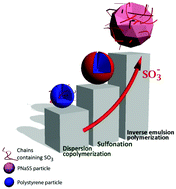Cross-linked polyelectrolyte microspheres: preparation and new insights into electro-surface properties†
Abstract
Polyelectrolyte microspheres find applications in many fields such as ion exchange columns, fuel cell membranes, and catalysis, to name a few. Synthesis of these microspheres by inverse emulsion polymerization offers various advantages due to the increased specific surface area and high surface charge density. The surface charge density of the obtained polyelectrolyte microspheres is a hundred times higher than that of either particles obtained by dispersion copolymerization of styrene and styrenesulfonic acid or sulfonated microspheres. The morphology, chemical structure, and electro-surface properties of the synthesized microspheres were studied by transmission and scanning electron microscopy, FTIR-spectroscopy, and conductometric and potentiometric titrations, respectively. Using the potentiometric titration it is possible to characterize the structure of the surface layer of polyelectrolyte microspheres as entirely as possible. The study of the ion-exchange capacity of polyelectrolyte microspheres shows that ion-exchange capacity is 2.1 meq g−1 in this case, which is more than 2 times higher than that of sulfonated microspheres, and 20 times higher than that of particles obtained by dispersion copolymerization.



 Please wait while we load your content...
Please wait while we load your content...